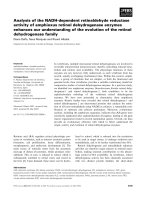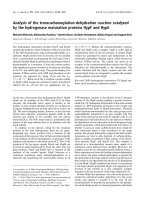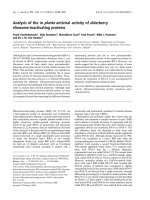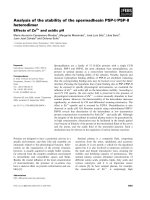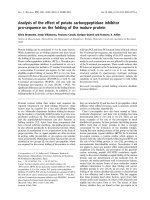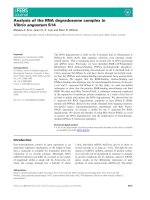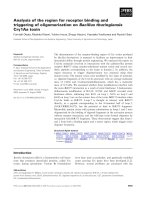Báo cáo sinh học: "Analysis of the real EADGENE data set: Comparison of methods and guidelines for data normalisation and selection of differentially expressed genes (Open Access publication)" potx
Bạn đang xem bản rút gọn của tài liệu. Xem và tải ngay bản đầy đủ của tài liệu tại đây (283.17 KB, 18 trang )
Genet. Sel. Evol. 39 (2007) 633–650 Available online at:
c
INRA, EDP Sciences, 2007 www.gse-journal.org
DOI: 10.1051/gse:2007029
Original article
Analysis of the real EADGENE data set:
Comparison of methods and guidelines
for data normalisation and selection
of differentially expressed genes
(Open Access publicatio n)
Florence Jaffr
´
ezic
a∗
,Dirk-Jande Koning
b
,PaulJ.Boettcher
c
,
Agnès B
onnet
d
,BartBuitenhuis
e
, Rodrigue Closset
f
,
Sébastien D
´
ejean
g
, Céline Delmas
h
, Johanne C. Detilleux
i
,
Peter D
ov
ˇ
c
j
,MylèneDuval
h
, Jean-Louis Foulley
a
,Jakob
H
edegaard
e
,HenrikHornshøj
e
,InaHulsegge
k
,LucJanss
e
,
Kirsty J
ensen
b
,LiJiang
e
,MihaLav r i
ˇ
c
j
,Kim-AnhL
ˆ
e
Cao
g,h
,
Mogens Sandø L
und
e
, Roberto Malinverni
c
, Guillemette
M
arot
a
, Haisheng Nie
l
, Wolfram Petzl
m
, Marco H. Pool
k
,
Christèle R
obert-Grani
´
e
h
, Magali San Cristob al
d
,EvertM.
va n Schothorst
n
, Hans-Joachim Schuberth
o
, Peter
S
ørensen
e
, Alessandra Stella
c
, Gwenola Tosser-Klopp
d
,
David W
addington
b
, Michael Wat son
p
,WeiYang
q
,
Holm Z
erbe
m
, Hans-Martin Seyfert
q
a
INRA, UR337, Jouy-en-Josas, France (INRA_J);
b
Roslin Institute, Roslin, UK (ROSLIN);
c
Parco Tecnologico Padano, Lodi, Italy (PTP);
d
INRA, UMR444, Castanet-Tolosan,
France (INRA_T);
e
University of Aarhus, Tjele, Denmark (AARHUS);
f
University of
Liège, Liège, Belgium (ULg2);
g
Université Paul Sabatier, Toulouse, France (INRA_T);
h
INRA, UR631, Castanet-Tolosan, France (INRA_T);
i
Faculty of Veterinary Medicine,
University of Liège, Liège, Belgium (ULg1);
j
University of Ljubljana, Slovenia (SLN);
k
Animal Sciences Group Wageningen UR, Lelystad, The Netherlands;
l
Wageningen
University and Research Centre, Wageningen, The Netherlands (WUR);
m
Ludwig-Maximilians-University, Munich, Germany;
n
RIKILT-Institute of Food Safety,
Wageningen, The Netherlands (WUR);
o
University of Veterinary Medicine, Hannover,
Germany;
p
Institute for Animal Health, Compton, UK (IAH);
q
Research Institute for the
Biology of Farm Animals, Dummerstorf, Germany
(Received 10 May 2007; accepted 6 July 2007)
∗
Corresponding author: florence.jaff
Article published by EDP Sciences and available at
or />634 F. Jaffrézic et al.
Abstract – A large variety of methods has been proposed in the literature for microarray data
analysis. The aim of this paper was to present techniques used by the EADGENE (European
Animal Disease Genomics Network of Excellence) WP1.4 participants for data quality control,
normalisation and statistical methods for the detection of differentially expressed genes in order
to provide some more general data analysis guidelines. All the workshop participants were
given a real data set obtained in an EADGENE funded microarray study looking at the gene
expression changes following artificial infection with two different mastitis causing bacteria:
Escherichia coli and Staphylococcus aureus. It was reassuring to see that most of the teams
found the same main biological results. In fact, most of the differentially expressed genes were
found for infection by E. coli between uninfected and 24 h challenged udder quarters. Very little
transcriptional variation was observed for the bacteria S. aureus. Lists of differentially expressed
genes found by the different research teams were, however, quite dependent on the method used,
especially concerning the data quality control step. These analyses also emphasised a biological
problem of cross-talk between infected and uninfected quarters which will have to be dealt with
for further microarray studies.
quality control / differentially expressed genes / mastitis resistance / microarray data /
normalisation
1. INTRODUCTION
Microarray analyses have been highlighted as an area of high priority within
the European Animal Disease Genomics Network of Excellence (EADGENE),
to study host-pathogen interactions in animals. Microarrays give the possibil-
ity to study the changes of expression of thousands of genes simultaneously
depending on the pathogen.
A large variety of methods for normalising and analysing microarray data
has, however, been proposed in the literature, and there is still no clear con-
sensus about which analysis process is recommended. The aim of this joint
research work was to review the methods and software packages used by the
EADGENE partners and to provide some general guidelines for further anal-
yses. To achieve this goal, a real data set was distributed among the workshop
participants. The real data was provided by an EADGENE funded microar-
ray study looking at the gene expression changes following artificial infec-
tion of cows with two different mastitis causing bacteria: Escherichia coli and
Staphylococcus aureus.Theeffect of artificial infection was tested over time in
12 dairy cows using three udder quarters in each cow for different time points
following infection and one for the control sample. The study included two
species of bacteria as well as several time-points, resulting in a true analytical
challenge (48 microarrays in total). The EADGENE partners who provided the
data were RIBFA and the Roslin Institute.
Detection of differentially expressed genes 635
In this paper three main steps of microarray data analysis will be discussed:
data quality control, normalisation and statistical methods for the detection of
differentially expressed genes. For each of these steps, the techniques used by
the workshop participants will be presented and compared.
2. MATERIALS AND METHODS
2.1. Presentation of the data
2.1.1. Comparison of E. coli vs. S. aureus elicited mastitis in cows using
transcriptomic profiling
The outcome of an udder infection (mastitis) is influenced by the species
of the infecting bacteria. Coliform bacteria, e.g. E. coli, tend to cause acute
infections with severe inflammatory symptoms, while others, like S. aureus
often result in chronic infections with less severe symptoms. The molecular
causes underpinning these differences in host pathogen interactions are largely
unknown. Here, we established a strictly controlled animal model to allow for
a systematic analysis of the different immune responses elicited by E. coli vs.
S. aureus, using strains of both pathogen species previously isolated from field
cases of mastitis. Healthy heifers were infected in the fourth month of their
first lactation. None of the cows had suffered a previous udder infection and
their somatic cell counts were well below 100 000 cells per mL of milk.
Three trials were conducted, each comprising four animals. First, 500 CFU
of our asseverated E. coli strain 1303 were infected into udder quarters at time
0, 12 and 18 h. The fourth quarter was kept as a control. The animals were
culled after 24 h and sampled. All animals showed signs of acute clinical mas-
titis by 12 h after challenge: increased somatic cell count (SCC), decreased
milk yield, leucopenia, fever and udder swelling. Quantitative RT-PCR analy-
sis revealed that the expression of Toll-like receptor (TLR) 2, TLR4 and beta-
defensin-encoding genes was greatly enhanced in the 24 h infected quarters,
while the relative mRNA copy numbers remained low in the uninfected con-
trol quarters, which is coherent with the microarray results presented below.
Secondly, animals infected with 10 000 CFU of the S. aureus strain 1027 in a
similar scheme over 24 h (n = 4) showed no or only modest clinical signs of
mastitis. No evidence of alteration in TLR or beta-defensin-encoding indicator
genes for activated innate immune defense was found. In the third trial, four
animals were infected with the S. aureus pathogen. For each of them (i) two
quarters were infected at time 0, (ii) a third quarter at time 60 h, and animals
636 F. Jaffrézic et al.
were killed after 72 h. Hence, there were two quarters per animal with S. au-
reus inoculated for 72 h, one quarter with the pathogen inoculated for 12 h and
again one control quarter. S. aur eus caused clinical symptoms and increased
expression of the TLR and beta-defensin-encoding indicator genes in this third
group of animals, infected over 72 h (n = 4).
Assignment of the animals to become inoculated with E. coli or S. au-
reus was completely at random and arbitrary. The three trials were conducted
at three different days. Inter-animal transmission can be excluded, thanks to
proper handling of the inoculates. The identity of the pathogens were verified
from re-isolates of milk samples. In addition to the classical microbiological
verification, strain identity was verified using diagnostic digests of pathogen
residential plasmids as criteria.
The clinical and qRT-PCR data proved that the E. coli infected animals all
developed symptoms of acute mastitis, earlier than 24 h after infection. S. au-
reus pathogens, however, needed more time to elicit not only clear infection
related symptoms of mastitis, but also the activation of the immune defense
within the udder. We also noted a clear host-individual influence in this re-
gards. Samples from all these udder quarters were carefully asseverated and
stored in liquid nitrogen, for subsequent DNA-microarray analyses.
The microarray experiment was carried out using the Bovine 20K array
(ARK-Genomics). A common reference design was used and the reference
sample was made up of all 48 RNA samples. The reference sample was la-
belled with Cy3 and the treatment with Cy5 on each microarray slide. All
samples were collected in Hannover (Germany) by Holm Zerbe, Hans-Joachim
Schuberth, and Wolfram Petzl, and had been validated by Hans-Martin Seyfert
in Dummerstorf (Germany). The samples were shipped to the Roslin Institute
for transcriptome profiling by Elizabeth Glass and Kirsty Jensen.
The Bovine 20K microarray was subdivided in 48 blocks, with 12 rows and
4 columns. Each of the 48 resulting blocks was printed with its own unique
print-tip (i.e. there are 48 print-tips). Each block consisted of 30 sub-grid rows
and 30 sub-grid columns. Almost all (19 705) features were printed in duplicate
within the same block, 324 printed 4 times and 2 printed 12 times. Annotations
were provided by Mark Fell of the Roslin Institute and were distributed among
the workshop participants. The microarrays were scanned and data were ex-
tracted using Bluefuse ( />Bluefuse does not provide an estimate of the background intensity, and there-
fore no further background correction was possible on these data.
Detection of differentially expressed genes 637
2.2. Normalisation of the data
2.2.1. Data quality control
Several quality control procedures were used by the authors and Table I
presents an overview of these techniques. Most of the teams used the spot
quality indicators provided by the scanning software (Bluefuse) to make de-
cisions about excluding spots from the analysis. There are several indicators
of quality provided by the Bluefuse software: (a) the probability that a clone
is expressed in the tissue studied (PON) with a value between 0 and 1; (b) a
manual quality flag from A (good) to E (bad); (c) a compound ‘confidence’
quality indicator between 0 and 1; and (d) a binary quality indicator that is 0
(bad) or 1 (good). The simplest approaches were to remove spots with manual
flags or with Bluefuse flag values equal to D or E because their confidence
levels were lower than 0.30 (meaning a poor quality of spot). In more sophisti-
cated approaches, raw data were visualised using R-LimmaGUI [15] to check
the overall quality by several criteria, such as M boxplots, M-A plots, and
Cy5-Cy3 scatter plots. INRA_T pointed out, using simple descriptive statistics
that array BTK2-74 was different from the other slides given the mean, mini-
mum and maximum, and should be deleted from the analysis. M-A plots of the
raw data were atypical and showed a clear ‘fishtail’ pattern for low intensity
spots, where the log-ratios (M) diverged, as shown in Figure 1. This indicated
relatively noisy data due to many spots with low intensities. ROSLIN there-
fore proposed to add 2
8
to all the channel intensities. IDL deleted spots with
intensities above 65 000 (oversaturated spots) or with values within the exper-
imental error, i.e. spots smaller than 400 [8]. AARHUS suggested a quality
weighting of the data [9] by down-weighting the spots with low quality based
on Bluefuse ‘Confidence’ or ‘P ON’ measurements. For all teams, data were
log2 transformed and the log-ratio between Cy5 and the reference Cy3 was
considered as the observed intensity.
2.2.2. Correction for spatial and intensity-dependent bias
Normalisation of the data is a two-step process including first a correction
for spatial bias, and second a correction for intensity-dependent bias. Correc-
tion for spatial bias was usually carried out separately for each block (print-tip)
of each array, by either subtracting the median for each block, or by subtracting
the corresponding row and column means (RC correction, excluding control
spots) [1]. The intensity dependent bias was removed by either block-Loess
correction [14], or by a global Loess correction [17]. Two levels for each of
638 F. Jaffrézic et al.
Tab le I. Overview of the methods used by each team for data quality control and normalisation.
Team Quality Control (QC) Normalisation Softwares
ROSLIN (1) Genespring.
(2) 2
8
added to all spot intensities. Three plots per slide:
MA, print-tip box-plot and spatial plot. Summary statis-
tics were used.
Four normalisations: global and local dye and spatial
correction.
Genespring
Bioconductor (Limma and Marray)
with changes.
AARHUS Diagnostic plots. Weights for data quality were used
based on ‘Confidence’ and ‘P-ON’ weights.
Print-tip Loess correction was used with different
weights.
Bioconductor Limma.
INRA_T Clones with quality control flag A, B or C (n = 6948)
were kept. Slide BTK2-74 was omitted.
Arrays and genes were mean centered. R.
IDL Would use background information but it was not pro-
vided here with Bluefuse. Spot edits, oversaturated spots
and spots smaller than 400 were removed.
Print tip Loess.
Heterogeneous variance correction [8].
Limma
ULg1 2-step Wolfinger procedure.
Random effect model with a fixed dye effect, a random
print-tip effect and an interaction term.
SAS
SLN Samples were normalised to uninfected group. (1) Genespring.
(2) Orange
/>IAH Blank, auto_excl and man_excl spots were removed.
Replicate spots were averaged.
Median normalisation for each slide. Scale normalisation
between arrays.
Co-Express programmed in R.
INRA_J Manual flags were considered as missing (man_excl). Global Loess and print-tip correction.
Replicate spots were considered as independent observa-
tions.
R.
ULg2 ‘DNA’, ‘blank’, ‘buffer’, ‘nothing’, ‘light reference’
were deleted. Spots were deleted if quality is bad (E) for
25 consecutive spots.
Global Loess. R, Maanova.
WUR M box-plots across slides.
Slide BTK2-74 was omitted.
Background (BG) was estimated and spots where Sig-
nal/BG <2 were deleted (from 20 k to 8.7 k genes).
Global Loess.
‘Rikilt’ normalisation.
Genemaths XT
Limma.
PTP Quality measures were used to delete the worst spots.
Non-relevant spots were also deleted.
Global Loess,
Mixed model across slides (Wolfinger 2-step procedure
[16]).
SAS
Detection of differentially expressed genes 639
Figure 1. The “fishtail” appearance of M-A plots for the raw data for slides 1–4. Lines
are Loess curves for each of the 48 print-tips. Control spots were omitted.
the two normalisation steps were examined by ROSLIN to check whether these
steps should be global (i.e., chip-wide) or local (i.e., print-tip). The choice was
informed by comparisons of summary measures of M-A plots, spatial heat dia-
grams and print-tip box-plots for the raw data and all four normalisations. The
local spatial bias (RC correction) and local intensity-bias (MA normalisation)
were found here to perform consistently well regarding the spatial plot in the
F-test of differences between blocks in M values, the M-A plot in the F-test of a
block MA correction versus a chip-wide MA correction, and the print-tip box-
plots in the mean inter-quartile range of M. This local RC-MA normalisation
640 F. Jaffrézic et al.
Figure 2. M-A plots after normalisation for ROSLIN team with a print-tip Loess cor-
rection for slides 1 to 4.
was therefore chosen by this team for normalising the data. Figure 2 shows
the corresponding M-A plots after normalisation. Since E. coli and S. aureus
samples were hybridised always at the same channel and against a common
reference, the setup of this experiment requires no dye swap effect correction,
which is often a source of experimental noise.
Another possible approach for data normalisation is to use an ANOVA
model. This approach was used here by two teams (ULg1 and PTP) using a
two-stage mixed-model approach [5] with the Proc Mixed SAS
procedure.
In the first stage, initial models were fitted to each array separately to take
account of the experimental systematic effects on the base-2 logarithm of the
Detection of differentially expressed genes 641
pixel values. The model included a fixed dye effect, a random print-tip ef-
fect and an interaction between dye and print-tip effects. Effects of print-tip
were considered as random because of the manufacturing variation expected
between print-tips. Residuals obtained from this model were then analysed to
find differentially expressed genes.
It has to be emphasised that all the genes were used in the normalisation
procedures presented above, based on the underlying assumption that most of
the genes are not differentially expressed and that the observed differences are
only due to technical artefacts. This assumption has to be checked for every ex-
periment and may sometimes not be verified, especially when using dedicated
chips.
2.2.3. Software packages used f o r the data normalisation
Four teams (ROSLIN, AARHUS, IDL, WUR) used the Bioconductor pack-
age Limma – Linear Models for Microarray Analysis [13] in R for data nor-
malisation. A bioinformatics pipeline was developed by IDL to handle both
data normalisation and detection of differentially expressed genes accessible at
. The SAS
software was used for nor-
malisation using an ANOVA model.
2.3. Methods used to find differentially expressed genes
Three main biological questions were investigated on this data set: which
genes are differentially expressed (1) between the two types of infection
(E. coli and S. aureus); (2) over time within each bacteria; and (3) across time
and bacteria. Table II presents an overview of the statistical methods used by
each team to find differentially expressed genes.
2.3.1. ANOVA approach with different variance models
Three teams (ROSLIN, AARHUS, IDL) used for this part of the analyses
the Bioconductor R package Limma [13], which allows complex designs and
provides robust t- and F-statistics for differential gene expression by the use
of empirical Bayes methods (eBayes) for shrinking the residual variances of
genes towards their approximate median value. This approach is based on an
inverse chi-square prior on the variances [12]. The linear model used here ac-
counted for within-array replicate spots and included the effects of time and
642 F. Jaffrézic et al.
Table II. Overview of the methods and software packages used by each team for the detection of differentially expressed genes.
Team Comparison Single gene analysis
Statistical method
Softwares
ROSLIN Uninfected quarters, between infec-
tions and across time within each in-
fection.
(1) Genespring.
(2) Limma + FDR.
(1) Genespring.
(2) Bioconductor Limma with eBayes correc-
tion.
AARHUS Infected at different times vs. unin-
fected for each separate experiment.
Limma + FDR. Bioconductor Limma with eBayes correc-
tion.
INRA_T E. coli infected vs. unifected. Fisher test with FDR. R.
IDL For both E. coli and S. aureus:in-
fected at different times vs. unin-
fected.
Limma
FDR + Fold change cut-off.
Limma
ULg1 Infected vs. uninfected.
E. coli vs. S. aureus
SAS
, Wolfinger mixed model,
FDR correction.
SAS
SLN Infected vs. uninfected. 2-fold change.
Anova with FDR.
(1) Genespring.
(2) Orange />IAH S. aureus vs. E. coli Derived from clusters and differences over
time.
Co-Express programmed in R.
INRA_J Different time points within infection
or same time point between infec-
tions.
Anova model,
Structural mixed model for variances,
Time course with EDGE.
‘SMVar’ function programmed in R
EDGE [3].
ULg2 For S. aureus: infected vs. uninfected. Bayesian analysis of variance. R, BAMarray
WUR Infection and time
combined.
2-way ANOVA.
1-way ANOVA.
TIGR [11].
PTP Within and between infections at dif-
ferent times.
Linear mixed model:
bacteria effect, and time as a categorical or
continuous variable.
SAS
.
Detection of differentially expressed genes 643
challenging bacteria. Differentially expressed genes between types of infec-
tion were tested based on the robust t-statistics and differential expression of
genes over the different time points used a moderated F-test. Another approach
also based on an ANOVA model but with a different variance model was used
by INRA_J. It is based on a structural mixed model on the variances [7] and
is implemented in R in the ‘SMVar’ function. Here, a fixed condition effect
and a random gene effect were considered to model the log of the variances.
Two other teams (WUR and ULg2) used TIGR Multiple Experimental Viewer
v4.0 [11] and the BAMarray software [6] for Bayesian analysis of variance, re-
spectively. In the latter approach, genes are clustered into groups of equal vari-
ances and data are rescaled to satisfy the equal variance assumption. Then, a
hierarchical Bayesian model is used to synthesise information across all genes
simultaneously, and estimated effects for genes unlikely to be differentially
expressed are shrinked to zero to enhance patterns of interest.
2.3.2. Models for time-course study
In the ANOVA models presented above, observations were assumed to be
independent, which was not the case in this time-course study since measure-
ments were made at different time points for each animal. Three longitudinal
approaches were proposed here to take these correlations into account and find
differentially expressed genes over time in the two infections.
The first approach was performed by PTP using the Mixed procedure of
SAS
. A gene-by-gene analysis was performed on the residuals obtained from
the normalisation process. The effects included in this linear mixed model were
the following: a fixed bacteria effect, a non-parametric mean curve by fitting
the time effect as a qualitative variable or a parametric function of time (linear
and quadratic regression on time), and the interactions between bacteria and
these time effects. A linear random regression model was considered (using a
random cow effect and an interaction with time). A quadratic random regres-
sion model was also investigated but did not converge. For each gene-specific
model, custom hypothesis tests were constructed to determine whether gene
expression was different between healthy and infected quarters, or between
quarters infected with E. coli and S. aureus at different times.
The second longitudinal approach considered in this workshop by INRA_J
was based on the Edge package [3]. In this gene-specific model, the population
average time curve was modelled using a natural cubic spline function and
the correlation structure was fitted with a random intercept. Two biological
questions can be addressed with this approach. First, is the effect for each gene
644 F. Jaffrézic et al.
constant for each infection. Second, is the expression pattern over time, i.e. the
average time curve, for each gene the same in the two infections.
In the last approach, an ANOVA was performed by INRA_T on the expres-
sion value for each E. coli clone, with the time factor as an explanatory variable
(4 levels: 0, 6, 12 and 24 h). A standard Fisher test was used to test the effect
of time on each gene. After selection of the differentially expressed genes over
time, a clustering approach based on smoothed expression curves [4,10] was
used to find clusters of genes with similar expression profiles. This second step
is presented in the post-analysis paper.
2.3.3. Correction for multiple tests
Regarding the correction for multiple tests, all teams used the classical
Benjamini and Hochberg [2] correction at a 5% False Discovery Rate (FDR)
threshold, either using R functions or the SAS
Multitest procedure.
3. RESULTS
Although various methods were applied for normalising and analysing the
data, it was reassuring to see that most of the teams found similar biological
results. First, it was found that the largest number of differentially expressed
genes was obtained when comparing samples from udder tissue challenged
for 24 h with E. coli to non-challenged tissue. In contrast, challenging with
S. aureus did not result in a dramatic transcriptional response. Second, quite
a large number of differentially expressed genes were detected at time zero
between the two groups of infections. This showed a cross-talk between udder
quarters or an invasion by immune cells from the infected quarters, since all
udders were collected simultaneously at the end of exposure. We will present
here the results obtained with the Bioconductor Limma package (ROSLIN in
Tab. II) which was used by many teams and was shown to perform well for
differential gene expression analysis.
The uninfected quarters from the E. coli infection exhibited differential ex-
pression in 402 clones representing 359 genes compared to the S. aureus un-
infected quarters. The most up-regulated genes included metallothioneins and
lipopolysaccharide binding protein, indicating that an immune response has
been triggered in the uninfected quarters. Furthermore, the MHC class II in-
variant chain molecule, CD74, was down-regulated, suggesting that the cell
populations present in the mammary gland quarter had altered in response to
the infection of neighbouring quarters. Considerable overlap was observed in
Detection of differentially expressed genes 645
the gene lists from the E. coli uninfected quarters and the 331 genes declared to
be differentially expressed at 6 h post E. coli infection. More than 600 clones,
representing 538 genes exhibited differential expression at 12 h post infection,
and the number of differentially expressed genes reached a maximum at 24 h
post infection when the transcription of 1190 genes was affected. Many of the
most up-regulated genes at this time point are associated with the influx of
neutrophils into the infected gland, including S100 calcium binding proteins
A8, A9 and A12, colony stimulating factor 3 and several chemoattractants for
neutrophils, e.g. interleukin 8 and chemokine (C-X-C motif) ligand 1 and 2.
No gene was identified as being significantly differentially expressed during
S. aureus infection using the cut-off FDR value of 0.05. This lack of statistical
support principally results from high levels of variation between the biolog-
ical replicates. This may be an artefact of the experimental procedure; large
mammary gland samples were collected for RNA extraction which may have
comprised variable amounts of S. aureus infected tissue, because the bacteria
causes a localised infection. Therefore the gene lists were expanded to include
those genes with t-test p-values less than or equal to 0.01 and a fold change
greater than or equal to 1.5. At 6 h post S. aureus infection, 154 genes ex-
hibited differential expression. The most highly up-regulated gene was lacto-
transferrin, an antimicrobial protein secreted in milk. Interestingly, this gene
was only observed to be up-regulated at 24 h post E. coli infection. At 12
and 24 h post infection 182 and 266 genes were declared differentially ex-
pressed, respectively. However, the number decreased to 97 by 72 h post in-
fection. There was some overlap between the lists of differentially expressed
genes during E. coli and S. aur eus infections, including the up-regulation of
superoxide dismutase and the down-regulation of interleukin 7. The analysis
of the microarray data identified two putative genes that may be indicative of
S. aureus infection. Leucine rich repeat kinase 2 was down-regulated at all
4 time points during S. aureus infection but not during E. coli infection. In ad-
dition, a clone (AJ814901) whose sequence currently only matches EST was
also down-regulated during S. aureus infection.
Various comparisons of lists of differentially expressed genes found by the
EADGENE teams were performed. We focussed mainly on the comparison of
the differentially expressed genes found between time 0 and 24 h for the E. coli
infection, which exhibited the largest transcriptional response. It was found
that although all the teams found a large number of differentially expressed
genes between these two time points, the lists of genes were still dependent
on the method chosen. Figure 3 gives the Venn diagram for the differentially
expressed genes found by three of the teams. They used different data quality
646 F. Jaffrézic et al.
Figure 3. Venn diagram for the lists of differentially expressed genes found for E. coli
between times 0 and 24 h after infection at a 5% Benjamini and Hochberg threshold
for IDL, INRA_J and PTP teams. Normalisation and analyses methods used by these
teams are presented in Tables I and II.
control procedures and different normalisation and analyses methods: the IDL
team used a print-tip Loess normalisation and the Limma package, INRA_J
used a global Loess normalisation and the structural model for variances, and
PTP used the global Loess and a 2-step mixed model approach with SAS
.
It was found that 468 genes were detected in common for these three teams,
and 790 genes were detected in common for IDL and INRA_J. It is interesting
to also note that IDL and PTP teams, despite using very different approaches,
found 658 genes in common among the 761 genes detected by PTP. When fo-
cussing only on the 500 most differentially expressed genes found by the three
teams, only 206 genes were found in common for the three approaches, as
shown in Figure 4. A larger consistency in the ranking of the genes could have
been expected, especially between IDL and INRA_J which used Limma and
SMVar shrinkage approaches, respectively. In fact, both teams found here only
272 genes in common among the first 500, although the two methods were
found in previous studies [7] to provide very similar results in the detection of
differentially expressed genes. The main difference in the analyses performed
by these two teams was in the data quality control step. On the contrary, 323
were found in common between IDL and PTP teams, who used very different
statistical approaches for the detection of differentially expressed genes but a
more similar approach for data quality control, with the removal of oversatu-
rated and low quality spots. The data quality control step therefore appears here
Detection of differentially expressed genes 647
Figure 4. Venn diagram for the 500 first differentially expressed genes found for
E. coli between times 0 and 24 h after infection for IDL, INRA_J and PTP teams.
to be essential for microarray data analysis but a consensus for best practice
still has to be reached.
It has to be emphasised that this study presented the number of genes that
were declared to be differentially expressed by statistical methods, at a 5%
Benjamini-Hochberg threshold. A biological validation still has to be per-
formed, however, for most of these genes to be able to differentiate between
the true positives and the false positives.
4. DISCUSSION
Quality control of the data proved, in this workshop, to be an important first
step. Simple summary statistics for each slide, as well as print-tip box-plots,
MA and spatial plots can be used for quality checks. Recommendation would
be to delete spots that were flagged as low quality, or to perform some quality
weighting [9]. It was found here that one of the slides was of very poor quality
and had to be deleted from the analysis. Bluefuse does not use a measure of
background intensity from pixels around the spot, nor does it make an explicit
estimate from within-spot pixels, and therefore the background intensities were
not provided.
Following quality control, the normalisation step is divided into two steps:
a correction for spatial bias and a correction for intensity-dependent bias. The
first step is performed on each block (print-tip) for each array separately either
648 F. Jaffrézic et al.
by subtracting the median for each block, subtracting the corresponding row
and column means (excluding control spots) or by including a random array
block effect in the Wolfinger et al. [16] two-step mixed model approach. The
second step is performed using either a local or global Loess correction. Us-
ing various quality control plots, one of the teams found that the local Loess
correction was the most adapted for this data set. Many teams used the Bio-
conductor R package Limma to perform this normalisation. More diversity
was observed among the teams for the data quality control step than for the
normalisation step.
Two main approaches were used for the statistical analysis of these data.
The first approach was based on ANOVA models and allowed the detection
of differentially expressed genes using two by two comparisons with robust
t-tests. The construction of these robust t-statistics was based either on the
eBayes Limma shrinkage [13] or on a structural mixed model on variances [7]
– SMVar function in R. These analyses provided lists of genes that were dif-
ferentially expressed within each infection at different time points, as well as
between the two infections. The second approach was based on longitudinal
models and took into account the correlations between measurements involved
in this time-course study. For this second set of analyses, a random regres-
sion model was used with SAS
in a two-step mixed model approach, and the
EDGE package developed by Dabney et al. [3] was applied to these data. These
analyses allowed the detection of genes that had a pattern of expression chang-
ing over time or that differed for both infections. Since these data come from
a longitudinal study, it is advisable here to use the latter approaches that take
into account correlation between measurements rather than the ANOVA based
models which assume independence of the observations. Correction for mul-
tiple tests was performed by all the teams using Benjamini and Hochberg [2]
FDR approach at a 5% threshold.
Although various quality control procedures, data normalisation and anal-
ysis methods were used, all the teams generally obtained the same main bi-
ological results. In fact, all participants found that most of the differentially
expressed genes were found between the uninfected group and quarters that
had been challenged by the E. coli pathogens for 24 h. On the contrary, very
little transcriptional response was observed for the S. aureus infection.
It can be argued, however, that the robustness observed here concerning the
biological results may be due to the extremely large transcriptional response
with the E. coli infection. These conclusions may therefore not be generalised
to other experiments with only small transcriptional changes. Moreover, sev-
eral methods used here such as the shrinkage approaches (Limma, SMVar,
Detection of differentially expressed genes 649
BAMarray) were designed to improve the performance under high-noise, low
replicate, small-change settings. The E. coli data, which exhibited a very large
transcriptional response, may therefore not allow pointing out the subtle dif-
ferences between these various methods.
All the teams pointed out the heterogeneity between the two uninfected
groups which should have been comparable but exhibited an unexpectedly
large number of differentially expressed genes. This observation raised an im-
portant biological and experimental design problem about cross-talking be-
tween udder quarters. This issue will be studied more thoroughly by the EAD-
GENE biologists in further experiments.
A comparison of the lists of differentially expressed genes found by the
workshop participants was performed for E. coli between times 0 and 24 h. Due
to the various methods used for normalising and analysing the data, the lists
were not exactly similar. It was reassuring, however, to find that even using two
very different approaches, (1) normalisation by print-tip Loess and analysis
with Limma in R; and (2) global Loess and Wolfinger’s two-step mixed model
approach in SAS
, the lists of differentially expressed genes still remained
quite similar.
Here all participants had the same raw data set to analyse. Comparison of
methods may have been easier, however, if each step had been evaluated sep-
arately: first, data quality control, then normalisation on a common previously
cleaned data set and finally detection of differentially expressed genes on a
common previously normalised set of data. Criteria to compare procedures
for data quality control is still an open and essential issue for microarray data
analysis.
ACKNOWLEDGEMENTS
The authors wish to acknowledge Caroline Channing, Karin Smedegard and
WP1.4 for organising the workshop, Zerbe et al. for providing the real data
sets and EADGENE for financial support (EU Contract No. FOOD-CT-2004-
506416).
REFERENCES
[1] Baird D., Johnstone P., Wilson T., Normalization of microarray data using a
spatial mixed model analysis which includes splines, Bioinformatics 20 (2004)
3196–3205.
[2] Benjamini Y., Hochberg Y., Controlling the false discovery rate: a practical and
powerful approach to multiple testing, J. R. Stat. Soc. B 85 (1995) 289–300.
650 F. Jaffrézic et al.
[3] Dabney A.R., Leek J.T., Monsen E., Storey J.D., Edge man-
ual, Department of Biostatistics, University of Washington,
2006.
[4] Déjean S., Martin P.G.P., Baccini A., Besse P., Clustering time series gene ex-
pression data using smoothing spline derivatives, EURASIP J. Bioinformatics
Syst. Biol. (2007) ID 70561.
[5] Gibson G., Wolfinger R.D., Gene expression profiling using mixed models, in:
Saxton A.M. (Ed.), Genetic analysis of complex trait using SAS
,SAS
User
Press, Cary NC, 2004, Chap. 11, pp. 251–278.
[6] Ishwaran H., Rao J.S., Kogalur U.B., BAMarray
TM
: Java software for Bayesian
analysis of variance for microarray data, BMC Bioinformatics 7 (2006) 59.
[7] Jaffrézic F., Marot G., Degrelle S., Hue I., Foulley J L., A structural mixed
model for variances in differential gene expression studies, Genet. Res. 89 (2007)
19–25.
[8] Pool M.H., Hulsegge B., Janss L.L.G., Background bias on cDNA micro-arrays,
EAAP, Uppsala, Sweden, 2005.
[9] Ritchie M.E., Diyagama D., Neilson J., van Laar R., Dobrovic A., Holloway
A., Smyth G.K., Empirical array quality weights for microarray data, BMC
Bioinformatics 7 (2006) 261, />[10] Robert-Granié C., Baccini A., Besse P., Déjean S., Ferré P.J., Liaubet L., Martin
P.G.P., San Cristobal M., Kinetics analysis of microarray data using semipara-
metric mixed models, 8th World Congress on Genetics Applied to Livestock
Production, Belo-Horizonte, Brazil, August 13–18, 2006.
[11] Saeed A.I., Sharov V., White J., Li J., Liang W., Bhagabati N., Braisted J.,
Klapa M., Currier T., Thiagarajan M., Sturn A., Snuffin M., Rezantsev A., Popov
D., Ryltsov A., Kostukovich E., Borisovsky I., Liu Z., Vinsavich A., Trush V.,
Quackenbush J., TM4: a free, open-source system for microarray data manage-
ment and analysis, Biotechniques 34 (2003) 374–378.
[12] Smyth G.K., Linear models and empirical Bayes methods for assessing differ-
ential expression in microarray experiments, Statist. Appl. Genet. Mol. Biol. 3
(2004) 3.
[13] Smyth G.K., Limma: linear models for microarray data, in: Gentleman R.C.,
Carey V.J., Dudoit S., Irizarry R., Huber W. (Eds.), Bioinformatics and
Computional Biology using R and Biocondutor, Springer, New York, 2005,
pp. 397–420.
[14] Smyth G.K., Speed T., Normalization of cDNA microarray data, Methods 31
(2003) 265–273.
[15] Wettenhall J.M., Smyth G.K., LimmaGUI: A graphical user interface for linear
modeling of microarray data, Bioinformatics 20 (2004) 3705–3706.
[16] Wolfinger R.D., Gibson G., Wolfinger E.D., Bennett L., Hamadeh H., Bushel
P., Afshari C., Paules R.S., Assessing gene significance from cDNA microarray
expression data via mixed models, J. Comp. Biol. 8 (2001) 625–637.
[17] Yang Y., Dudoit S., Luu P., Peng V., Ngai J., Speed T., Normalization for cDNA
microarray data: a robust composite method addressing single and multiple slide
systematic variation, Nucleic Acids Res. 30 (2002) e15.


